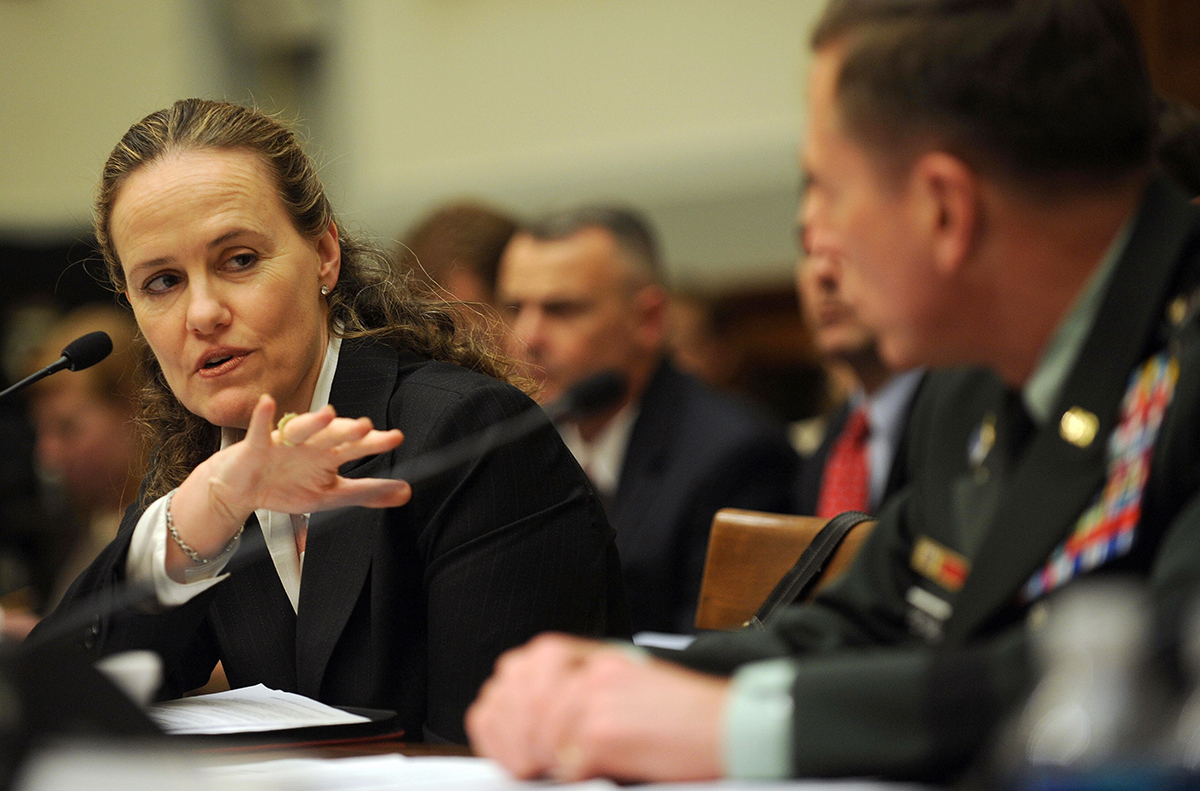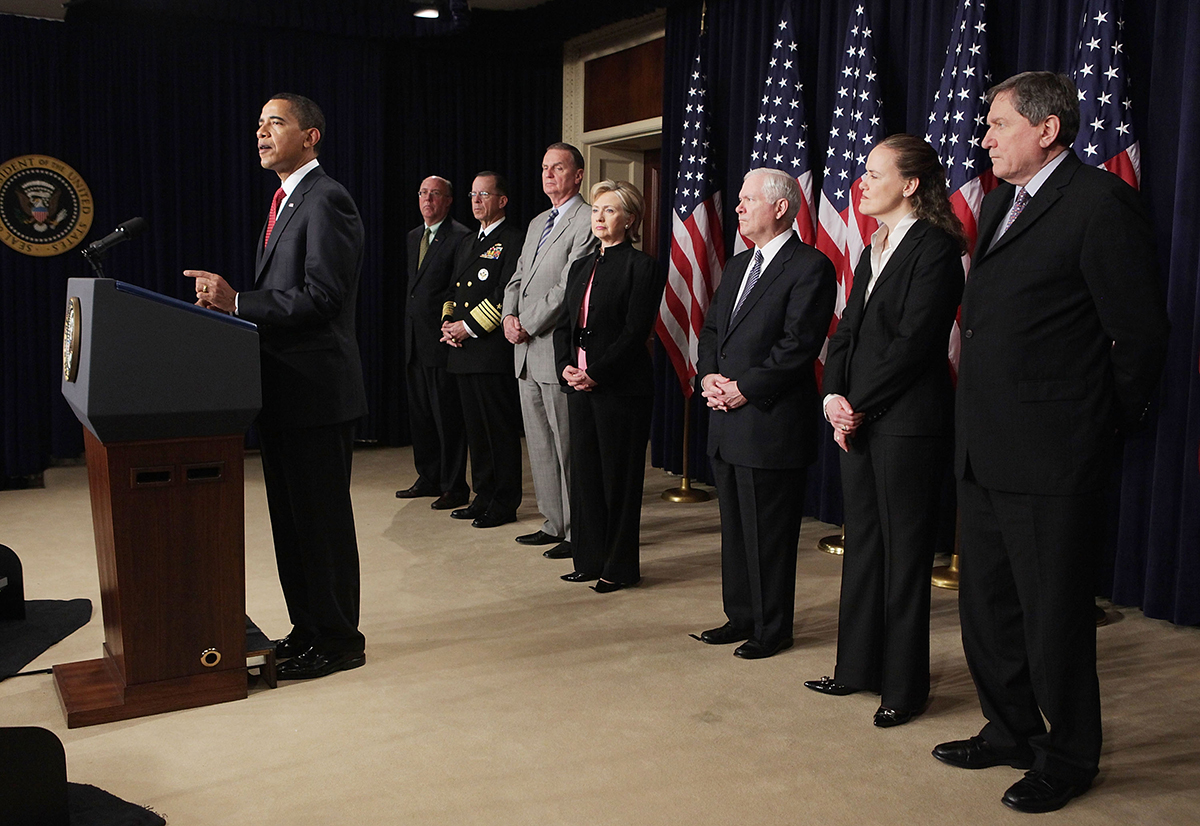"Though we have achieved progress, our work is not over. That is why I support the mission of the Arms Control Association. It is, quite simply, the most effective and important organization working in the field today."
U.S. Nuclear Weapons Policies: A Conversation with Michèle Flournoy
July/August 2017
Interviewed by Kingston Reif and Maggie Tennis
 Michèle Flournoy is co-founder and chief executive officer of the Center for a New American Security. She served as undersecretary of defense for policy from February 2009 to February 2012. The interview was conducted May 25 by Kingston Reif and Maggie Tennis. This transcript has been edited for length and clarity.
Michèle Flournoy is co-founder and chief executive officer of the Center for a New American Security. She served as undersecretary of defense for policy from February 2009 to February 2012. The interview was conducted May 25 by Kingston Reif and Maggie Tennis. This transcript has been edited for length and clarity.
ACT: The Defense Department announced in April that the Trump administration’s Nuclear Posture Review (NPR) had commenced. Each president since the end of the Cold War has undertaken such a review. President Donald Trump has declared his ambition to “greatly strengthen and expand” U.S. nuclear weapons capabilities, and he has also criticized the 2010 New Strategic Arms Reduction Treaty (New START) with Russia. Do you think the NPR is likely to set in motion significant changes in U.S. policy or is likely to reflect more continuity than change?
Flournoy: I don’t think we know yet. What we can say is that some of the president’s early statements on these issues are not based in any deep policy review or any in-depth briefings he’s received. He hasn’t really focused on this set of issues yet as far as I know. I think we’ve also learned in other areas that as he dives into an issue, he can evolve his position, he can learn and refine his views. So, I wouldn’t put too much emphasis on some of his initial statements or first gut reactions to topics as they have come up.
That said, I do think this NPR will be very consequential because it’s coming at a time when we face major decisions about how much and how to reinvest in the nuclear triad. So many systems are up for modernization. Do we modernize everything that we have, which is essentially the current plan, or do we use the opportunity of the NPR to ask some more fundamental questions about what we need for deterrence in the future? I think this NPR has the potential to be very consequential.
On arms control, the administration will need to decide, along with Russia, whether to extend New START and its monitoring regime for five years beyond its February 2021 expiration date as allowed by the treaty, to negotiate some kind of follow-on agreement, or to go forward without legally binding, verifiable limits on the world’s two largest nuclear arsenals. What would be the consequences if the United States withdraws from New START or did not seek to extend it? How do you think the administrations should seek to engage Russia on arms control?
If we withdrew or failed to extend New START, it would be an unforced error on our part. An easy win is to pursue an extension of the treaty as is. It buys us predictability. It buys us transparency and verification measures. It buys us a lot that contributes to stability at a time when the other dimensions of the relationship with Russia are both in flux and under tremendous scrutiny. It’s probably unrealistic to expect, based on what [Russian President Vladimir] Putin has said and what Russia is actually doing, that we can negotiate a new arms control framework anytime soon. I think politically that would be a tough thing on our side until we get to the bottom of questions like Russia’s role in our elections and in campaigns to undermine other Western democracies. My view is that we should pursue an extension to buy some time and to buy some stability and then see what’s possible in the future.
 Shifting to another arms control agreement, the United States has accused Russia of deploying a ground-launched cruise missile with a range prohibited by the 1987 Intermediate-Range Nuclear Forces (INF) Treaty. Do you think it’s possible to convince Russia to return to compliance, and how should the United States respond to Russia’s alleged violation?
Shifting to another arms control agreement, the United States has accused Russia of deploying a ground-launched cruise missile with a range prohibited by the 1987 Intermediate-Range Nuclear Forces (INF) Treaty. Do you think it’s possible to convince Russia to return to compliance, and how should the United States respond to Russia’s alleged violation?
It’s pretty clear that they are violating the treaty. I think we should respond in a multidimensional way. First, press them through diplomatic channels to come back into compliance. I think this could be a multilateral diplomatic effort to put some pressure on Russia to come clean. There’s been some precedent for this. Back in the day when we believed that the Krasnoyarsk radar was violating the Anti-Ballistic Missile Treaty, they denied it, they denied it, they denied it for years; and then finally, as the political context changed, they eventually admitted it and stopped the construction. We have some track record of Russia coming back into compliance. Do I think that’s likely anytime soon on the INF Treaty? No. But the last thing we should do is say we’re going to walk away from the treaty because then the failure of the treaty regime would be on us and not them.
The second key dimension of this is that we need to do a clear-eyed analysis of the military relevance of this new system and what are the ways that we can counter it. I think people are too quick to jump to a symmetric response: “Oh, well this means we need to redeploy U.S. nuclear intermediate-range missiles in Europe.” Well, not necessarily. Let’s take a look at how significant these systems are. What is the full range of countermeasures that we might adopt? I suspect there are a range of conventional countermeasures and other asymmetric approaches that might be used to make this militarily not a huge problem for us.
According to some estimates, the United States is on track to spend more than $1 trillion over the next 30 years to sustain, replace, and refurbish nuclear delivery systems, warheads, and supporting infrastructure. Numerous Pentagon officials in recent years, as well as outside experts, have warned about the affordability problem posed by the current approach. Are tough trade-offs going to have to be made in the military budget to accommodate the current modernization plans? Do you think there are options to potentially alter the pace and scope that would be more cost effective while still providing a strong deterrent?
While we need to invest in ensuring we maintain a strong, stable, effective nuclear deterrent, we also have to make sure that it’s one that we can afford and sustain. If you look at the full range of challenges we’re going to face in the future and the need to modernize other aspects of our military, there’s a lot of competition for a limited amount of dollars—limited even under the increases that are being projected by this administration. So, trade-offs do have to be made. I think that rather than automatically modernizing every single nuclear program on the books, we should use the NPR as an opportunity to say, “Can we get to a stronger, more enduring, more sustainable nuclear deterrent with a different mix of systems and capabilities?” I do think we need to debate that in looking at the broad architecture of the triad, but also looking at specific systems and what is the most cost-effective approach to creating a more modern set of capabilities.
 The NPR will almost certainly review the existing U.S. nuclear force structure, which currently includes a triad of sea-, land-, and air-based delivery systems. In testimony to the Senate Armed Services Committee in January 2015, James Mattis, now the defense secretary, raised the question, “Is it time to reduce the triad to a dyad, removing the land-based missiles? This would reduce the false-alarm danger.” What contribution do you believe that intercontinental ballistic missiles (ICBMs) make to deterrence today? Has the rationale for the ICBM leg changed since the end of the Cold War?
The NPR will almost certainly review the existing U.S. nuclear force structure, which currently includes a triad of sea-, land-, and air-based delivery systems. In testimony to the Senate Armed Services Committee in January 2015, James Mattis, now the defense secretary, raised the question, “Is it time to reduce the triad to a dyad, removing the land-based missiles? This would reduce the false-alarm danger.” What contribution do you believe that intercontinental ballistic missiles (ICBMs) make to deterrence today? Has the rationale for the ICBM leg changed since the end of the Cold War?
In the middle of the Cold War when the risk of a bolt-from-the-blue strike was real or we believed it to be real, I think the ICBM leg was pretty critical to deterrence. In the world we live in now and given the advance of other technologies, I think that it’s a question as to (a) whether we need an ICBM leg and (b) if we do need some ICBM leg, how big does it really have to be to serve the purpose. I think that is one of the fundamental questions that the NPR should take on, whether we should move to a dyad and, even if you believe we should stay at a triad, can the balance change. I think everybody agrees that the most survivable leg, where we have the most competitive advantage, is the submarine leg. The bomber force, we’re going to get for both conventional and nuclear purposes.
From a triad perspective, the focus is going to really be on the future of the ICBMs, what’s strategically necessary and what’s most cost effective. In particular, I think the Defense Department should more seriously consider further extending the life of the existing Minuteman III ICBMs as a cheaper near-term alternative to the current plan to build an entirely new ICBM system.
Moving to the bomber leg, Mattis at his confirmation hearing declined to affirm the need for a new fleet of nuclear air-launched cruise missiles (ALCMs), stating that he’d have to study the rationale in more detail. Critics argue that retaining nuclear-armed ALCMs is redundant given current plans to build the stealthy, nuclear-capable B21 “Raider” long-range bomber, armed with the upgraded B61 nuclear gravity bomb, as well as to modernize the other two legs of the triad. There is also the growing lethality of conventionally armed air- and sea-launched cruise missiles. In your view, do ALCMs make a unique contribution to the credibility of the U.S. nuclear deterrent?
This is one where, honestly, I am studying the issue because I haven’t made up my mind. I think if the B21 is everything we hope it will be, you may not need this. But if adversary anti-access, area-denial capabilities, particularly sophisticated air defenses, continue to progress—and perhaps there are issues with the ability of our current and future bombers to penetrate those defenses—you might want a cruise missile in your arsenal. That’s not so much from a war-fighting perspective but more from the perspective of an assured ability to hold targets at risk and therefore deter your adversary.
Do you have any indication from your time in government or since that there are questions about whether our submarine-launched ballistic missiles (SLBMs) or our ICBMs would be able to reach even the most well-defended targets?
No, no, so you do have the options from ICBMs and SLBMs as well. As I said, I’m working my way through this, but I don’t have a definitive answer.
The Trump administration’s NPR may also reconsider the declaration in the 2010 NPR Report that life extension programs for nuclear warheads “will not support new military missions or provide for new military capabilities.” Is there a military requirement for new or, in particular, low-yield warheads that don’t currently exist in the U.S. nuclear stockpile?
I think you have to add to that question, is that unique requirement worth all that that would mean in terms of starting to design, test, build, and deploy new nuclear weapons? Let’s put it this way, I have yet to hear a case for a new nuclear warhead that is compelling enough to take on both the investment costs and the political costs of going down that road.
As you also know, nuclear weapons figured very prominently in the 2016 presidential election campaign. Many Americans relearned or learned for the first time that the president alone has the ability to launch, particularly ICBMs and SLBMs, within minutes of a decision to do so and that the military retains and exercises the ability to launch ICBMs under attack. In your view, does vesting the power to use nuclear weapons in the hands of one person still make sense? Are there steps that you believe could be taken to reform current U.S. nuclear launch protocols?
With the current construct, the potential for your ICBMs to be under attack or taken out within minutes creates enormous time pressure in the decision-making process if you’re going to launch under attack. As a practical matter, it means that the president has to make a decision with very little information and very little time. He has advisers on the call with him to help. But it is, having gone through the rehearsals for these things, a very compressed timeline for a very momentous decision. I would like to see measures taken to increase the decision-making time. This has been part of what has motivated people like Bill Perry, Sam Nunn, George Shultz, and others to question whether we need to keep launch under attack as a practice. This is part of what their concern has been, along with the risk of accident or miscalculation.
I’m not ready to completely rewrite the decision-making structure of our government on this question, but I do think there’s real value to increasing the decision-making time because, by definition, you’re going to have more knowledgeable experts able to advise the president meaningfully if you give him more time in that circumstance.
 Can you envision a scenario where a president of the United States would make the most consequential decision a president will have ever made in a matter of minutes?
Can you envision a scenario where a president of the United States would make the most consequential decision a president will have ever made in a matter of minutes?
It’s hard to imagine. When I think of the presidents I’ve worked for, like Barack Obama, it would be hard for such a deliberative, careful, decision-maker to make that kind of decision absent being 1,000 percent sure that we were actually under attack and a nuclear explosion was going to happen on U.S. soil. The whole launch-under-attack scenario assumes a president is willing to make that decision in the absence of certainty. I think that’s an open question in some cases. Would Trump make that decision? Maybe. We don’t know. Let’s hope we never find out. But I think we are failing the president, any president, at some level to put them in that position. There have to be better ways to provide more time to verify information and make a fully informed decision. Because of our history with false alerts and mistakes made where training tapes were thought to be real, we have to be very careful not to miscalculate given the consequences.
Last year, it was reported that the Obama administration considered but ultimately rejected changing U.S. nuclear declaratory policy to state that the United States would not be the first to use nuclear weapons. Are there circumstances under which the benefits of first use of nuclear weapons would outweigh the costs, and if nuclear weapons are used by one nuclear-armed adversary against another, what guarantee do we have that such use would not escalate to a full-scale nuclear exchange with the United States or against a U.S. ally?
I think if you have nuclear use by one nuclear power against another, the risk of full-scale escalation is there. The case that has, in recent years, stopped presidents from fully embracing [a] no-first-use [policy] has been the potential for catastrophic weapons of mass destruction [WMD] attacks of a different nature—for example, a successful, massive bio-attack that would have consequences on the order of a nuclear attack in terms of people killed and so forth. It’s that exceptional case that has kept people from making the full statement.
I personally believe that we should emphatically state that the purpose of nuclear weapons is to deter the use of other nuclear weapons. Period. In a real world instance, if a president felt that there was an exceptional case where he had no other option to respond to a catastrophic WMD attack that was non-nuclear, okay, then that’s a presidential decision at that point. But I think there’s benefit to declare that we don’t believe these weapons are for war-fighting and that we stand in opposition and in contrast to countries like Russia who talk in a very cavalier manner about escalating to nuclear use in order to try to stop conventional war, which is incredibly irresponsible and incredibly dangerous. I think there’s room to strengthen U.S. declaratory policy in this area.
|
'Tremendous Experience' ACT: One of your first jobs in Washington early in your career was as a senior analyst at the Arms Control Association, working on nuclear weapons policy and defense issues. Could you tell us how that experience impacted your career path? Flournoy: It was a tremendous experience and opportunity. It was really the first time where I was able to develop a real depth of expertise in a given area and to build a body of work as a young analyst. That became important for a number of reasons. One is, it attracted a very important mentor to me. Based on an Arms Control Today article I had written, Ted Warner reached out to me and introduced himself and said, “I agreed with every word of your article. I’m working on the same thing over at RAND [Corp.] We should meet.” As my career unfolded later, Ted was the person who hired me and gave me my first job in the Pentagon. |
